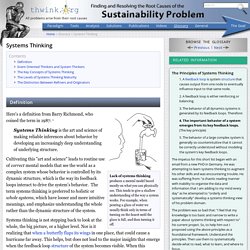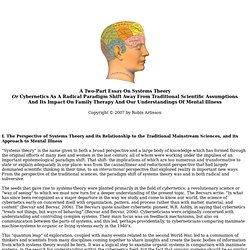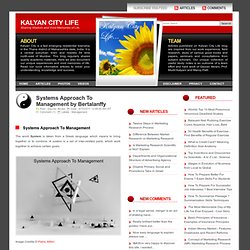

Systems Thinking - Tool/Concept/Definition. Definition Lack of systems thinking produces a mental model based mostly on what you can physically see.

This tends to give a shallow understanding of the way a system works. For example, when pouring a glass of water we usually think only in terms of turning on the faucet until the glass is full, and then turning it off. Here's a definition from Barry Richmond, who coined the term in 1987: Introduction to Systems Thinking. Intro to Systems thinking. Introduction to Systems ThinkingDaniel Aronson Systems thinking has its foundation in the field of system dynamics, founded in 1956 by MIT professor Jay Forrester. Professor Forrester recognized the need for a better way of testing new ideas about social systems, in the same way we can test ideas in engineering. Systems thinking allows people to make their understanding of social systems explicit and improve them in the same way that people can use engineering principles to make explicit and improve their understanding of mechanical systems.
The Systems Thinking Approach The approach of systems thinking is fundamentally different from that of traditional forms of analysis. The character of systems thinking makes it extremely effective on the most difficult types of problems to solve: those involving complex issues, those that depend a great deal dependence on the past or on the actions of others, and those stemming from ineffective coordination among those involved. What is Systems Theory? Systems theory is an interdisciplinary theory about the nature of complex systems in nature, society, and science, and is a framework by which one can investigate and/or describe any group of objects that work together to produce some result.

This could be a single organism, any organization or society, or any electro-mechanical or informational artifact. As a technical and general academic area of study it predominantly refers to the science of systems that resulted from Bertalanffy's General System Theory (GST), among others, in initiating what became a project of systems research and practice. Systems theoretical approaches were later appropriated in other fields, such as in the structural functionalist sociology of Talcott Parsons and Niklas Luhmann. Overview Margaret Mead was an influential figure in systems theory. Contemporary ideas from systems theory have grown with diversified areas, exemplified by the work of Béla H. A system from this Russell Ackoff, Béla H. History Cybernetics. The Paradigm Shift of Systems Theory. I.

The Perspective of Systems Theory and its Relationship to the Traditional Mainstream Sciences, and its Approach to Mental Illness “Systems theory” is the name given to both a broad perspective and a large body of knowledge which has formed through the original efforts of many men and women in the last century, all of whom were working under the impulses of an important epistemological paradigm shift. Current Thinking - Systems Thinking. Systems thinking. Impression of systems thinking about society[1] A system is composed of interrelated parts or components (structures) that cooperate in processes (behavior).

Natural systems include biological entities, ocean currents, the climate, the solar system and ecosystems. Designed systems include airplanes, software systems, technologies and machines of all kinds, government agencies and business systems. Systems Thinking has at least some roots in the General System Theory that was advanced by Ludwig von Bertalanffy in the 1940s and furthered by Ross Ashby in the 1950s.
Business leaders need systemic thinking for sustainability. The economy is in the tank and thousands of people are out of work.

At the same time, the planet is dangerously heating up and ecological systems are declining. What are we to make of these troubles? Are they merely the result of poor policies? Or is something more fundamental at play? The roots of our difficulties are simple, yet for many business and political leaders completely hidden from view. To resolve today's challenges, our leaders must overcome the erroneous perspectives that created the predicament.
Systems Approach To Management by Bertalanffy. Systems Approach To Management The word System is taken from a Greek language which means to bring together or to combine.

A system is a set of inter-related parts, which work together to achieve certain goals. Image Credits © Pablo Alfieri. The McKinsey 7S Framework. Ensuring That All Parts of Your Organization Work in Harmony Learn how to use the 7-S Framework, with James Manktelow & Amy Carlson.

How do you go about analyzing how well your organization is positioned to achieve its intended objective? This is a question that has been asked for many years, and there are many different answers. Some approaches look at internal factors, others look at external ones, some combine these perspectives, and others look for congruence between various aspects of the organization being studied. Ultimately, the issue comes down to which factors to study. While some models of organizational effectiveness go in and out of fashion, one that has persisted is the McKinsey 7-S framework. The 7-S model can be used in a wide variety of situations where an alignment perspective is useful, for example, to help you: The McKinsey 7-S model can be applied to elements of a team or a project as well.
Systemic vs. Systematic. When was the last time you thought about why your business does what it does?

Every business exists to produce a certain result — a service or a product — but have you ever asked yourself, "Why do we do it this way? " That question is the essence of strategic thinking. Develop Systems Thinking. To cope with complexity, leaders have been taught to divide things into simpler component parts and to manage these as best they can.

This often leads to today’s solutions creating tomorrow’s problems. Systems thinking is required for long term leadership success in our complex world. This Workplace Development Guide provides 10 activities to develop your systems thinking while you work. Systems thinking will give you a more accurate picture of reality so that you can work with a system's natural forces in order to achieve the results you desire. Your solutions will have greater viability in the long term through mitigating unintended consequences. 'Develop Systems Thinking' is one of a series of Workplace Development Guides designed to provide you with practical and convenient e-learning activities that you can integrate with your everyday work as part of your ongoing leadership development.
Purchase in 3 easy steps. Traits that enable Systems Thinking. Systems Thinking Principles. Systems Thinking - A Disciplined Approach. A Disciplined Approach Systems thinking is an approach for developing models to promote our understanding of events, patterns of behavior resulting in the events, and even more importantly, the underlying structure responsible for the patterns of behavior. If we are interested in addressing a particular situation it is only through our understanding of the underlying structure that we will be able to identify the most appropriate leverage points to effect change within the system. After years of doing what I thought was systems thinking, one day I asked myself the fateful question, "How is it that I actually go about doing this?
" Finding that I didn't have a real good answer to this question prompted me to write this paper in an attempt to sort out an answer. Approach. 17 Habits of Systems Thinking. Practical guidelines in the use of the open systems approach. Productivity Improvement General applications Although the open systems approach has been in use for some decades now, it continues to be more than a useful tool offering a number of benefits: It facilitates analysis of a complex problem by focusing on specific important elements within the system and in the environment.

A problem can thus be simplified and outlined more clearly. Interrelationship Diagram. Interrelationship Diagram. Interrelationship Diagram Example. Systems Thinking. Systems Thinking by Peter Senge A cloud masses, the sky darkens, leaves twist upward, and we know that it will rain. We also know that after the storm, the runoff will feed into groundwater miles away, and the sky will grow clear by tomorrow. All these events are distant in time and space, and yet they are all connected within the same pattern. Each has an influence on the rest, an influence that is usually hidden from view. Systems Thinking Stool. 10 Useful Ideas on Systems. By Richard Wilkinson, 2001 “Real life is lived in a complex world system where all the subsystems overlap and affect each other.”
At the heart of systems thinking is the principle of interconnectedness. I compiled the following list to make this core idea translatable to daily life. System dynamics. Dynamic stock and flow diagram of model New product adoption (model from article by John Sterman 2001) System dynamics is an approach to understanding the behaviour of complex systems over time. It deals with internal feedback loops and time delays that affect the behaviour of the entire system.[1] What makes using system dynamics different from other approaches to studying complex systems is the use of feedback loops and stocks and flows.
These elements help describe how even seemingly simple systems display baffling nonlinearity. Overview[edit] System dynamics (SD) is a methodology and mathematical modeling technique for framing, understanding, and discussing complex issues and problems. Convenient GUI system dynamics software developed into user friendly versions by the 1990s and have been applied to diverse systems. Complexity Thinking. Systems thinking. Systems Thinking. © Copyright Carter McNamara, MBA, PhD, Authenticity Consulting, LLC.
Adapted from the Field Guide to Consulting and Organizational Development and Field Guide to Consulting and Organizational Development with Nonprofits. Systems Thinking Primer. Thinking with systems—Part 1. This week’s post is the first in a three-part introduction to the formal language of energy, as a foundation for subsequent discussion about just what it is that the energy concept deals with. My aim is to cover some essential ideas here—where they come from, how they relate to one another—in sufficient detail for later inquiry into the higher-level relationships between energy and societal futures. A central purpose of the approach I’m advocating is to maintain a connection between our understanding and use of energy-related concepts, and day-to-day experience of our physical world.
TEDxDirigo - Eli Stefanski - Making Systems Thinking Sexy. Center for Systemic Leadership. Systems Thinking World Wide Portal. Consortium for the Science of Sociotechnical Systems. Systems Thinking Resources - The U Process. Concepts and Frameworks The Five Learning Disciplines Developed by renowned systems thinker Peter Senge, these five disciplines each enhance the ability of a person or organization to use learning effectively. Leveraged together, they contribute heavily to the success of learning organizations, defined by Senge as, “…organizations where people continually expand their capacity to create the results they truly desire, where new and expansive patterns of thinking are nurtured, where collective aspiration is set free, and where people are continually learning to see the whole together.”
The five learning disciplines are Personal MasteryMental ModelsShared VisionTeam LearningSystems Thinking For descriptions of each of these disciplines, visit the Society for Organizational Learning’s website. U Process U Process, also know as Theory U, is a useful methodology for collectively approaching difficult problems and developing innovative, appropriate solutions. Biomimicry Double Loop Learning Tools. The art of systems thinking: essential skills for creativity and problem solving - Joseph O'Connor, Ian McDermott. Systems Thinking Games. Principles.